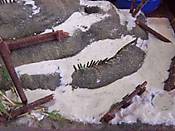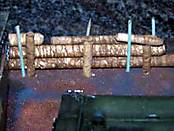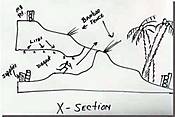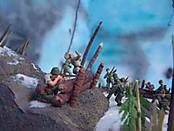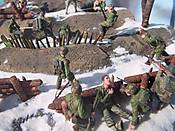1⁄351st Marines at Peleliu

history
In recent months, and largely due to the 60th Anniversary of VJ-Day, I have read more and more on the subject of the Pacific Theatre War of WWII. I noticed I had soon accumulated a large library of photos… It was time to get ambitious and push new terrain in the form of a diorama!The following diorama, entitled “Welcome to Peleliu” is described as it was built.
The subject I have chosen is the little-known but costly battle for the atoll of Peleliu. As here is ample material on this subject as of late, let me simply summarize the situation, by stating this was on of the bloodiest battles in the Central Pacific, pitting the 1st, 5th, and 7th Marines against the most elite of the Japanese Marine forces at that time. It was also one of the very first large-scale amphibious landing in the pacific theater, fought against an enemy who vowed to die to the last man.
The Japanese were dug into the coral and volcanic terrain, and were supported by an airfield, small artillery, and well entrenched and prepared defensive positions..
As the Japanese had ample time to prepare the island fortifications, many of the larger cave dwellings had generators, fans, ventilation, and full lighting, allowing the occupants to live underground permanently. This scene is a cross-sectional view of a squad of Japanese cave-masters being over-run by the 1st Marines.
It should be noted that while the US was ultimately victorious, the 1st Marines were decimated in the extended battle.
The Diorama
Before beginning a complex diorama, I find it helpful to sketch out the basic concept on a scratchpad, as shown in the photo.I built the base using stiff “marine” Styrofoam, layered in several tiers. Before gluing the sections in place, the cave area was carved out, and the battery powered lighting systems was glued into position. I smoothed in the contours of the various ridges, and then applied a smooth Spackle paste to cement the tiers together, and to provide strength as well as a uniform surface for the overall diorama.
I next crafted bamboo rods (used frequently as perimeter fencing) from wooden stake skewers, and palm logs made from wooden dowel rods of varying diameters. I also placed a small stand of defoliated bamboo near the edge of the diorama, not only to add color and setting, but to form a visual “stop” the the edge of the scene. Realistic bamboo leaves were glued in place, utilizing readily available silk foliage from a local florist shop. The approach to making both was quite simple and provided realistic (and in-expensive) effects…
In the case of the bamboo fencing, I manually shave the ends to a point, and then using the thin band of my rotary sander, shaped the “bamboo” by thinning areas with a thicker “joint” between them. These were then painted a faded sage green with my airbrush, and the darker knee joints were emphasized with a darker shade of the same color. The skewers were pushed through the dried plaster into the styro base.
To create the palm logs, I used a simple but effective technique of rotating the raw wood dowels against the edge of my band sander belt.
The sharp edge of the sander cut irregular bands similar to the growth pattern of palmtrees. While I cut the majority of the dowels into lengths to make the log wall, I also boiled two longer stick, and bent them by hand to detail two standing (although damaged!) palm trees on the opposite side of the dio for the same “eye stopper” effect. Both logs and tree trunks were pushed through the plaster base, and glued in place.
The next step was to apply a large amount of sand to the multiple levels of the overall scene. While this is not a “beach” scene, the island itself is described as being low profile near the edges, with volcanic rock, coral, and layers of ultra fine sand found all the way to the midline of the Umbrogol Ridge.
When doing small amounts of ground cover (ie, gravel, mud, debris) I find white glue diluted with water works fine, but when it comes sand, the best method I have found is CA glue. It is not the cheapest way to secure your ground, but it is the only way to insure that the fine sand stays put over the years. The method is quite simple… place all the sand where you need it to be, and then saturate the area with thin CA glue. It will spread quickly, so a little glue goes a long way, and should be applied a drop at a time. It will dry flat and clear, and the mixture of CA glue and sand forms a diamond-hard surface that will dull your finest drill bits! While the diorama shown took an entire large bottle ($5.97) of CA glue, it is also a huge diorama, measuring 16” x 16”.
Copyright ©2021 by Keith Magee. Images and/or videos also by copyright holder unless otherwise noted. The views and opinions expressed herein are solely the views and opinions of the authors and/or contributors to this Web site and do not necessarily represent the views and/or opinions of Armorama, KitMaker Network, or Silver Star Enterrpises. All rights reserved. Originally published on: 2005-05-13 00:00:00. Unique Reads: 24735




